FIND function in Excel - Usage and examples
The FIND function in Excel is a function of the TEXT function group, you can use the FIND function to find the position of a substring of text in another text. To understand more about FIND function, how to use and examples of using FIND function in Excel, let's follow the article below.
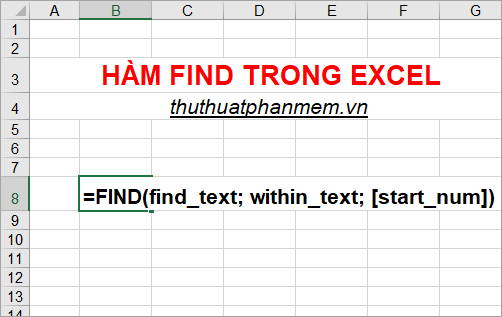
Here is the syntax, usage and examples of FIND function in Excel, please refer.
Description
The Find function is a function that searches for text strings in another text, the function returns the starting position of the first text string from the first character of the second text string.
- The Find function always counts each character as 1, whether it's a single byte or a double byte, regardless of the default language setting.
Syntax
= FIND (find_text; within_text; [start_num])
Inside:
find_text is the substring you want to find, and a required argument.
within_text is a required argument, this is the text containing the substring you want to search for the position.
start_num is an optional argument, you can enter or skip and if you omit start_num , the default will be 1. This is the position of the character you start searching within within_text (the within character of within_text is 1) character.
Note
- The FIND function is case sensitive and does not allow the use of wildcards. If you search is case-insensitive or you want to use wildcard characters then you can use the SEARCH function.
- If find_text is blank text (''), FIND returns the first character within within_text (or the numbered character is start_num or 1).
- If find_text is not in within_text , FIND returns the #VALUE! Error value.
- If start_num is less than zero or greater than the length of within_text, FIND returns the #VALUE! Error value.
For example
Example of using FIND function
You have the text of Albert Einstein , use the FIND function to find:
- Location of the first e.
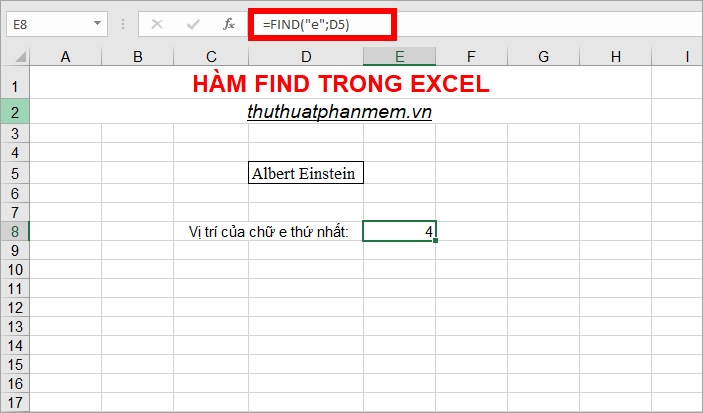
- The position of the first E.
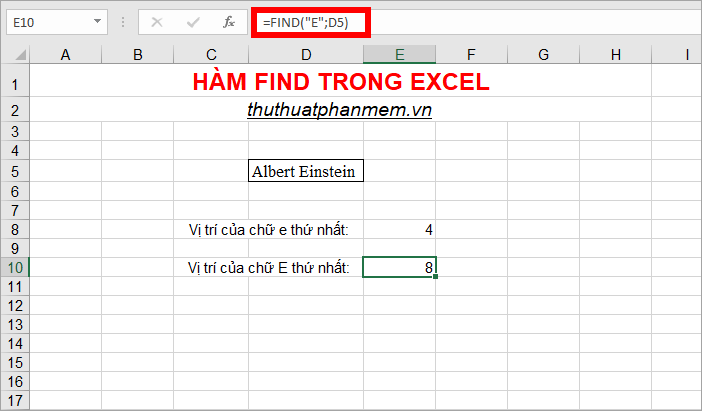
- Values of the first e, starting with the fifth character.
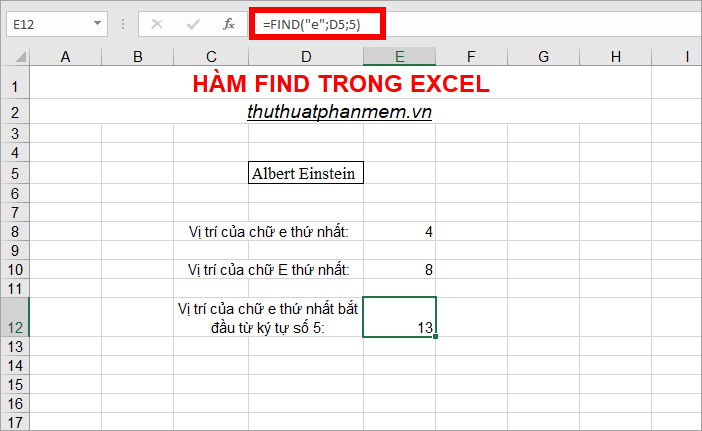
- The position of Einstein's string in the text string above.
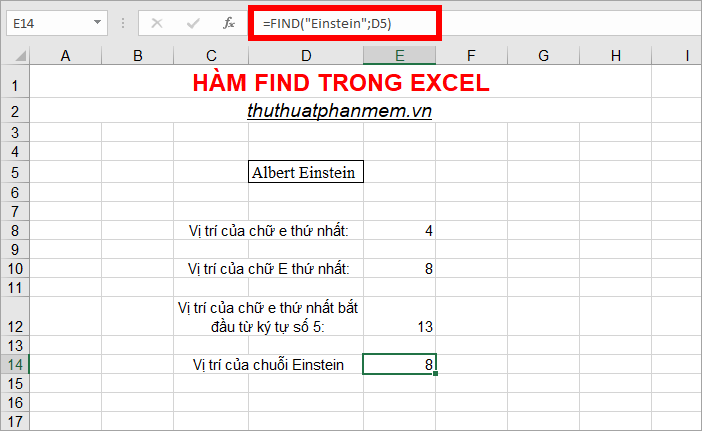
For example, use the FIND function in combination with the MID function to extract text
Assuming you have gmail accounts, you want to extract the gmail address in front of the @ character.
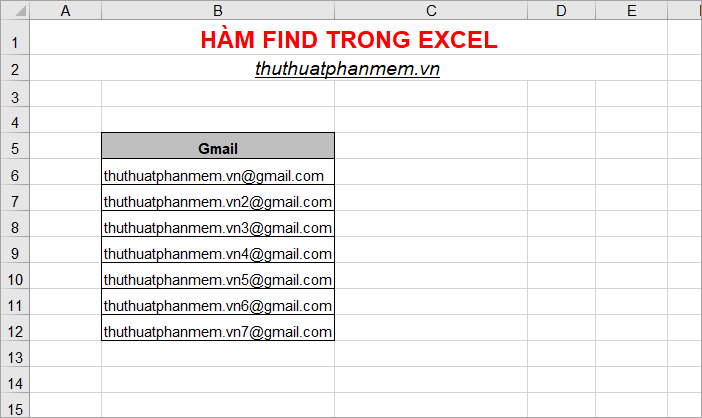
You do the following:
1. In the cell where you need to extract the gmail address, enter the following formula:
= MID (B6; 1; FIND ("@"; B6) -1)
The MID formula returns the character in cell B6 starting from position 1 to the position that FIND finds minus 1 character (@ for itself). The FIND function finds the position of the @ character in cell B6.
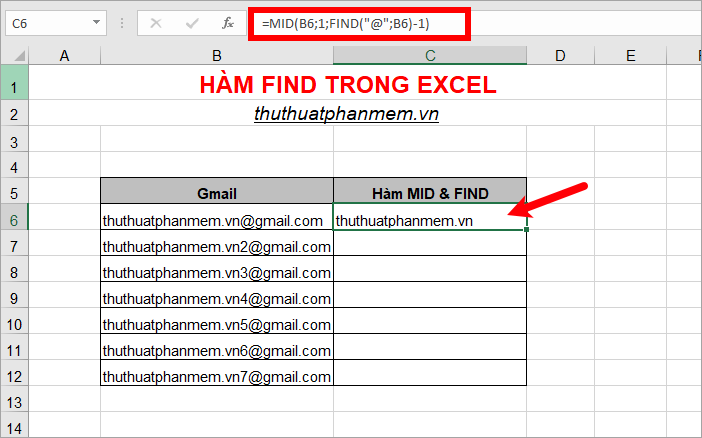
2. Next, copy the function formula down to the remaining cells, you will extract all gmail addresses.
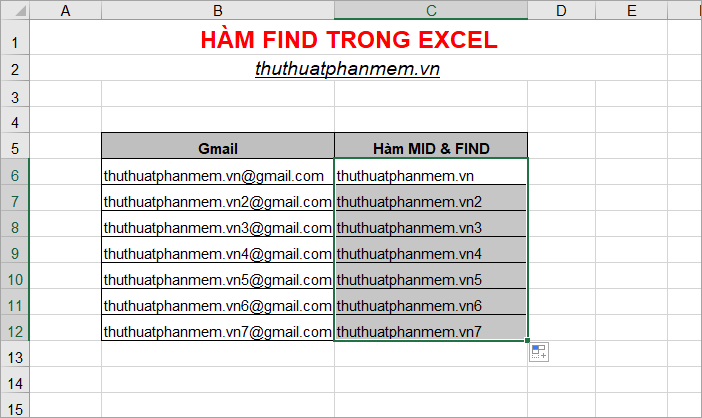
Above the article introduced to you FIND function in Excel, syntax, usage and specific examples of FIND function. Hopefully with the content that the article shared you will better understand the FIND function and apply the FIND function as needed. Good luck!
You should read it
- Excel date function - Usage and examples
- Function Address - The function returns the address of a cell in Excel (usage, examples, examples)
- OR function in Excel, how to use the OR function, and examples
- PMT function in Excel - Usage and examples
- DCOUNT function in Excel - Usage and practical examples
- Match function in Excel - Usage and illustrative examples
- VLOOKUP function to use and specific examples
- ROUNDUP function in Excel - Usage and examples
May be interested
- ROUNDUP function in Excel - Usage and examples
 today, the software tips will guide you how to use the roundup function to round numbers (rounding up) in excel. roundup function structure function syntax: = roundup (number, num_digits). in which: + roundup: is the function name. + number: is the number to be rounded up. + num_digits: is the number of digits after the comma you want to round. for example:
today, the software tips will guide you how to use the roundup function to round numbers (rounding up) in excel. roundup function structure function syntax: = roundup (number, num_digits). in which: + roundup: is the function name. + number: is the number to be rounded up. + num_digits: is the number of digits after the comma you want to round. for example: - DSUM function in Excel, how to use DSUM function and examples
 dsum function in excel, how to use dsum function and examples. the dsum function in excel is a fairly common function with a fairly simple usage. but if you do not know how to use the dsum function, you can refer to the following article to understand h
dsum function in excel, how to use dsum function and examples. the dsum function in excel is a fairly common function with a fairly simple usage. but if you do not know how to use the dsum function, you can refer to the following article to understand h - RANK function - Rank function in Excel - Usage and examples
 the rank function arranges equal numbers of the same rank. however, the duplication will affect the ranking of subsequent numbers. for example, you have the sequence number: 1,2,2,3,4 and are arranged in ascending order, so the order of the number 1 in the series is 5.
the rank function arranges equal numbers of the same rank. however, the duplication will affect the ranking of subsequent numbers. for example, you have the sequence number: 1,2,2,3,4 and are arranged in ascending order, so the order of the number 1 in the series is 5. - DCount function in Excel - How to use the DCount function and examples using the DCount function
 dcount function in excel - how to use the dcount function and examples using the dcount function you have a large list of students who want to get a high total score, but don't want to spend a lot of time. in this article, introduce to you the dcount function in excel. help c
dcount function in excel - how to use the dcount function and examples using the dcount function you have a large list of students who want to get a high total score, but don't want to spend a lot of time. in this article, introduce to you the dcount function in excel. help c - The search function satisfies many conditions in Excel - Usage and examples
 the search function satisfies many conditions in excel - usage and examples. in the process of processing data in excel many times you need to search for data that satisfies many conditions to extract data, so you are looking for a function that satisfies many things.
the search function satisfies many conditions in excel - usage and examples. in the process of processing data in excel many times you need to search for data that satisfies many conditions to extract data, so you are looking for a function that satisfies many things. - INDIRECT function in Excel - How to use INDIRECT function and examples using INDIRECT function
 indirect function in excel - how to use indirect function and examples using indirect function. you want to refer to a range of data without changing the formula in the cell. the following article introduces you to the indirect function in excel to help you reference
indirect function in excel - how to use indirect function and examples using indirect function. you want to refer to a range of data without changing the formula in the cell. the following article introduces you to the indirect function in excel to help you reference - Multiple if function - Usage and examples
 the following article gives you a detailed guide on how to use the multiple if function with examples. the if function is simplified in the sense that the function tests a value with a given condition, if it satisfies the condition that returns 1 value, if it does not satisfy the condition.
the following article gives you a detailed guide on how to use the multiple if function with examples. the if function is simplified in the sense that the function tests a value with a given condition, if it satisfies the condition that returns 1 value, if it does not satisfy the condition. - SUM function in Excel, sum function and examples
 sum is a basic excel function that allows users to quickly and accurately calculate the sum of columns or cells in an excel spreadsheet. for an overview of the concept, formula and how to use the sum function in excel, readers can refer to our article below. with many illustrative examples from simple to complex, readers can understand and quickly apply this function to practical work.
sum is a basic excel function that allows users to quickly and accurately calculate the sum of columns or cells in an excel spreadsheet. for an overview of the concept, formula and how to use the sum function in excel, readers can refer to our article below. with many illustrative examples from simple to complex, readers can understand and quickly apply this function to practical work. - Exponential functions in Excel - Usage and examples
 exponential functions in excel - usage and examples. are you looking for exponential functions in excel to use instead of the exponential operator '^'? so let's learn the exponential function in excel that the article shares below.
exponential functions in excel - usage and examples. are you looking for exponential functions in excel to use instead of the exponential operator '^'? so let's learn the exponential function in excel that the article shares below. - MATCH function in Excel, usage and examples
 the match function in excel helps determine the position of a value in a list or range of cells. this is a useful tool when working with large data sets and can be combined with the index function to retrieve more precise information.
the match function in excel helps determine the position of a value in a list or range of cells. this is a useful tool when working with large data sets and can be combined with the index function to retrieve more precise information.










 Phi symbols in excel, how to enter phi symbols and other special characters in Excel
Phi symbols in excel, how to enter phi symbols and other special characters in Excel How to lock Excel file, set password, pass for Excel file
How to lock Excel file, set password, pass for Excel file How to delete styles, delete styles, delete stubborn formating styles in Excel
How to delete styles, delete styles, delete stubborn formating styles in Excel Excel with hidden lines - How to hide lines and display hidden lines in Excel
Excel with hidden lines - How to hide lines and display hidden lines in Excel Offset function in Excel - Usage and examples
Offset function in Excel - Usage and examples